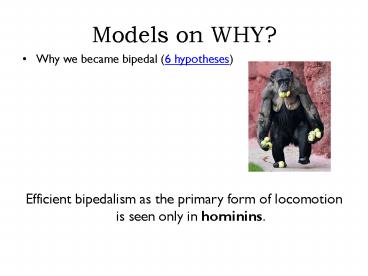Models on WHY? - PowerPoint PPT Presentation
Title:
Models on WHY?
Description:
... to date materials in the 5-1 mya range Carbon-14 method used to date organic material extending back to 75,000 years Thermoluminescence Uranium series dating ... – PowerPoint PPT presentation
Number of Views:56
Avg rating:3.0/5.0
Title: Models on WHY?
1
Models on WHY?
- Why we became bipedal (6 hypotheses)
- Efficient bipedalism as the primary form of
locomotion is seen only in hominins.
2
BECOMING HUMAN PART 1
- NOVA
3
Becoming Human review
- Lucy and bipedalism
- Habitual vs. Obligate Bipedalism
- Ossa Coxae
- Foot as stable support
- Longer legs
- Full knee extension
4
Hominins (us) are Hominoids
5
(No Transcript)
6
Hominins (us) review
- Defined by dental features, bipedal locomotion,
large brain size, and tool making behavior - Characteristics that developed at different
rates, called mosaic evolution
7
Biocultural Evolution The Human Capacity for
Culture
- All aspects of human adaptation, including
technology, traditions, language, religion,
marriage patterns, and social roles. - Culture is a set of learned behaviors it is
transmitted from one generation to the next
through learning and not by biological or genetic
means. - Material culture is part of the cultural complex
8
Oldowan Tool Industry
- The Oldowan is the first known industrial complex
in prehistory. It takes its name from Olduvai
Gorge, Tanzania - Oldowan tool use is estimated to have begun about
2.5 million years ago (mya), lasting to as late
as 0.5 mya. - It is thought that Oldowan tools were produced by
several species of hominids ranging from late
Australopithecus to early Homo.
Chopping tool
Biface tool
9
Dating (relative)
- Relative dating methods. These tell you that
something is older or younger than something else - Stratigraphy- based on the law of superposition,
which states that a lower layer is older than a
higher one - Flourine analysis, used to date remains of bone
- Biostratigraphy
- paleomagnetism
10
Dating (absolute)
- Absoulte dating methods
- Chronometric (Absolute) dating methods are based
on calendar years - K/Ar, or potassium argon method used to date
materials in the 5-1 mya range - Carbon-14 method used to date organic material
extending back to 75,000 years - Thermoluminescence
- Uranium series dating
- Electron spin resonance (ESR)
11
PALEOANTHROPOLOGY
- The Study of Old Humans
12
How far back?
7 8 million years 70 of our history resides
in Africa Extensive changes in the last 10
years 1992 3-4 million 1998 4.4 2000 6 2003 7
million
13
Early Hominoid Where to Look?
Rift Valley of East Africa Southern Africa
3 Major Groups Pre-australopiths
(7-4.4mya) Australopiths (4.2- 1 mya) Early
Homo (2.4 1.4)
14
Lucy 3.7 3.5 mya
Don Johanson Dicovered in Hadar in 1974 Lucy in
combination w/ Leakey footprints tell us about
locomotion and stature Lucy 40 of skeleton, one
of three most complete, Pre-100,000 Accurate
Dates due to Volcanic Ash layers
15
Laetoli (Ash Footprints)
Discovered in 1978
16
Laetoli (Ash Footprints)
- Convergent Big Toe
- Clearly Bipedal
- Arch
- Slow Moving Strol
- Short Stride































